Five Vampires
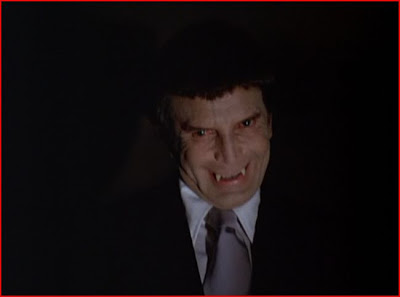 I suspect it’s not uncommon for a person to look back on the era of his earliest days and deem it the “perfect” time to have been a child; I certainly do. I regularly tell my own children how grateful I am to have been a kid in the 1970s. I say this not out of any particular love of plaid, shag carpet, or disco, but for two rather different reasons.
I suspect it’s not uncommon for a person to look back on the era of his earliest days and deem it the “perfect” time to have been a child; I certainly do. I regularly tell my own children how grateful I am to have been a kid in the 1970s. I say this not out of any particular love of plaid, shag carpet, or disco, but for two rather different reasons.
Firstly, ’70s were obsessed with the weird, the occult, and the apocalyptic. From The Exorcist to Soylent Green to In Search Of, there was clearly something in the air during that decade, something that had a profound effect on my youthful psyche and planted the seeds for many of my lifelong preoccupations. Secondly, the 1970s (at least as I experienced them in suburban Baltimore) was a time when contemporary television programming couldn’t keep up with demand, resulting in lots of reruns of older shows and movies being shown to plug holes in the schedule. The happy consequence of this for me was that I got to see tons of stuff made before I was born – including lots of great horror movies.
My imagination was thus founded on an unholy combination of old school horror films and Me Generation shlock – and I mean that in the best possible way. As a bookish kid with macabre sensibilities (owing perhaps to my being born two days before Halloween), the 1970s provided me with the raw materials needed to fuel my dreams and nightmares for many years to come. This is nowhere more apparent than when I look back on the various vampires I first encountered in those heady days.
I’m not 100% certain of this, but I suspect the first vampire I ever saw portrayed on the screen was Barry Atwater’s turn as János Skorzeny in the 1972 television movie The Night Stalker, in which he faced off against intrepid reporter Carl Kolchak (memorably played by Darren McGavin). Based on Jeff Rice’s The Kolchak Papers, The Night Stalker was hugely successful. At the time of its release, it was the highest-rated TV movie of all time and spawned not only a sequel, but a short-lived television program of the same name. So popular was the movie that it was regularly rerun, which is how I saw it. Skorzeny never once utters a word. Instead, he snarls, like a ravenous beast on the prowl. There’s nothing suave or enticing about him, let alone sympathetic. He lives – if that’s the word – for only one thing: blood. And he’ll go to any length to get it, including robbing a hospital of its supply. There’s a certain campiness to Atwater’s portrayal, but it works well in context and firmly established what a vampire was in my mind for years to come.
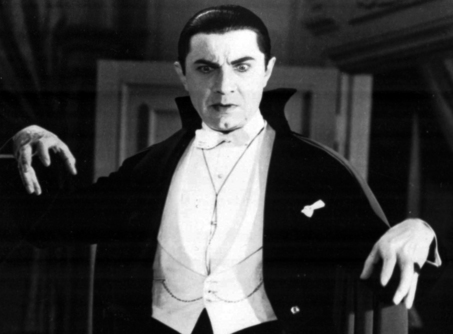 Bela Lugosi’s turn as Count Dracula in the 1931 Universal motion picture is something else entirely. Whereas Atwater is solely out for blood, Lugosi seemed to want your soul as well. Dracula is well-mannered and urbane, a sophisticated foreign gentleman equally unctuous and menacing. Nowadays, it’s sometimes hard to take this portrayal of the Count seriously. It’s been the subject of imitations and parodies (some of them unintentionally foisted on us by Lugosi himself) for decades. If you can leave those thoughts aside for a moment, though, and watch
Bela Lugosi’s turn as Count Dracula in the 1931 Universal motion picture is something else entirely. Whereas Atwater is solely out for blood, Lugosi seemed to want your soul as well. Dracula is well-mannered and urbane, a sophisticated foreign gentleman equally unctuous and menacing. Nowadays, it’s sometimes hard to take this portrayal of the Count seriously. It’s been the subject of imitations and parodies (some of them unintentionally foisted on us by Lugosi himself) for decades. If you can leave those thoughts aside for a moment, though, and watch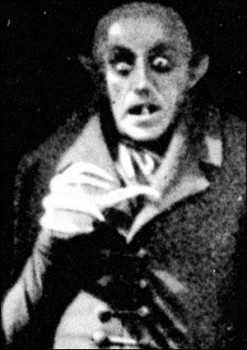 Dracula with fresh eyes, it’s hard not to marvel at what Lugosi – and, by extension, Bram Stoker, who started it all – did with the legend of the vampire. Rather than being a reanimated corpse with a taste for blood, the vampire becomes a seducer, a veritable incubus intent on destroying the souls of its victims along with their bodies.
Dracula with fresh eyes, it’s hard not to marvel at what Lugosi – and, by extension, Bram Stoker, who started it all – did with the legend of the vampire. Rather than being a reanimated corpse with a taste for blood, the vampire becomes a seducer, a veritable incubus intent on destroying the souls of its victims along with their bodies.
Ironically, the next vampire I encountered was Max Shreck’s Count Orlok in the 1922 silent film, Nosferatu. Though loosely based on Stoker’s novel, Orlok is nothing like Dracula. He is much more a folkloric vampire, with cadaverous, inhuman appearance, whose comings and goings are announced by rats and miasma. More importantly, he is actively harmed by sunlight and his final demise is brought about by exposure to it. Whereas János Skorzeny was bestial, Orlok was monstrous. I saw Dracula on a local TV station one Saturday afternoon; Nosferatu I saw at a screening in the basement of a public library one October evening. I sat there in the dark with a bunch of other people, many of them children like myself, and was enraptured by a movie so old that it was released before the advent of synchronized recorded sound. Much as I adored The Night Stalker and enjoyed Dracula, it was Nosferatu whose first viewing I remember most vividly even today.
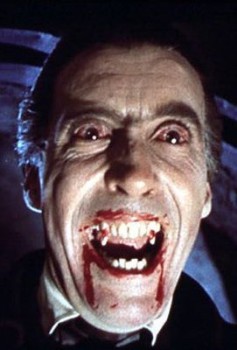 Though Count Orlok’s hideous visage haunted my imagination, I can’t say I was ever really frightened of him so much as fascinated. There was something dream-like and unreal about his pointed features, long fingers, and bug eyes. The same could not be said of Christopher Lee’s brilliant re-imagining of Count Dracula in the 1958 Hammer film, The Horror of Dracula. Lee’s take is almost perfect in my opinion. He’s every bit as urbane and seductive as Lugosi – at least on the surface. Beneath it all, though, he’s as much a monster as Orlok or Skorzeny. There’s something genuinely terrifying about Lee’s Dracula, helped in no small part by the copious amounts of bright blood for which Hammer movies were famous. Seeing him, even on the small screen of my television set late one Friday night, was scary.
Though Count Orlok’s hideous visage haunted my imagination, I can’t say I was ever really frightened of him so much as fascinated. There was something dream-like and unreal about his pointed features, long fingers, and bug eyes. The same could not be said of Christopher Lee’s brilliant re-imagining of Count Dracula in the 1958 Hammer film, The Horror of Dracula. Lee’s take is almost perfect in my opinion. He’s every bit as urbane and seductive as Lugosi – at least on the surface. Beneath it all, though, he’s as much a monster as Orlok or Skorzeny. There’s something genuinely terrifying about Lee’s Dracula, helped in no small part by the copious amounts of bright blood for which Hammer movies were famous. Seeing him, even on the small screen of my television set late one Friday night, was scary.
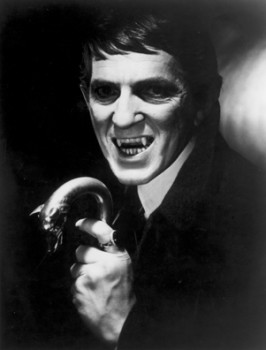 Last, but certainly not least, was Jonathan Frid’s Barnabas Collins. Growing up, my parents used to talk a lot about people they knew when they first got married who were huge fans of a television show called Dark Shadows, which they described as “a soap opera about a vampire.” To me, that was a bizarre concept, since soap operas were these boring shows my grandmothers watched. Dark Shadows ran between 1966 and 1971, so, again, I was too young to have seen it during its initial run, but it appeared on independent stations every now and again and I was intrigued enough to give it a go. Frid’s portrayal was sympathetic; Collins’s vampirism was the result of a jealous witch’s curse. He hated what he was and tried in vain to find a cure for it. In this respect, he was a bit like Lon Chaney’s wolf man. But make no mistake: sympathetic though he may have been, Barnabas Collins was still a monster and frequently his baser nature got the better of him, leading to tragic consequences.
Last, but certainly not least, was Jonathan Frid’s Barnabas Collins. Growing up, my parents used to talk a lot about people they knew when they first got married who were huge fans of a television show called Dark Shadows, which they described as “a soap opera about a vampire.” To me, that was a bizarre concept, since soap operas were these boring shows my grandmothers watched. Dark Shadows ran between 1966 and 1971, so, again, I was too young to have seen it during its initial run, but it appeared on independent stations every now and again and I was intrigued enough to give it a go. Frid’s portrayal was sympathetic; Collins’s vampirism was the result of a jealous witch’s curse. He hated what he was and tried in vain to find a cure for it. In this respect, he was a bit like Lon Chaney’s wolf man. But make no mistake: sympathetic though he may have been, Barnabas Collins was still a monster and frequently his baser nature got the better of him, leading to tragic consequences.
Taken together, these five portrayals more or less gave me my earliest conception of what a vampire was and ought to be. I’ve measured every subsequent portrayal against them, for good and for ill. Though quite diverse, what unites them is a sense of danger and menace. To varying degrees, they’re all monsters and becoming involved with them in any fashion is courting death, if not damnation. Not to sound like the old man that I’m rapidly becoming, but I prefer my vampires that way. Certainly there’s room for other interpretations, some of them rich with dramatic possibilities. However, I think something is lost in forgetting that a vampire is a blood-sucking corpse risen from the grave. It was that very notion that first drew me to vampires and that has sustained my interest in them over the decades. I consider myself lucky to have encountered them when I did.
“However, I think something is lost in forgetting that a vampire is a blood-sucking corpse risen from the grave.”
Amen!
It’s interesting that Stephen King once said that when he wrote ‘Salem’s Lot he was trying to reclaim the original monstrous pedigree of the vampire (harkening back to Nosferatu). I’m not really quite sure what he was reacting to–at first I offhandedly took him to mean a reaction to Anne Rice’s casting of vampires as sympathetic, even sexy and appealing characters. But checking the dates, I see ‘Salem’s Lot came out in 1975; Interview With the Vampire was published in 1976. At any rate, a few years ago King rather resoundingly skewered Stephanie Meyer and her sparkly vampires, so he’s been consistent in his view.
I’ll confess I’ve enjoyed some portrayals of the vampire as attractive protagonist (Spike and Angel in the Buffyverse), but c’mon, I don’t put that on to be scared.
A fellow child of the ’70s,
Nick
[…] Lord of the Undead, James Maliszewski examined Bela Lugosi’s turn as Count Dracula in the 1931 Universal film, and John R. Fultz looked at NBC’s new series Dracula.) Same with Sherlock Holmes (see the […]
[…] images and obsessions of that decade that left the strongest impressions on my young imagination. I’ve mentioned before that popular culture in the 1970s was awash with the weird, the occult, and the apocalyptic. The […]